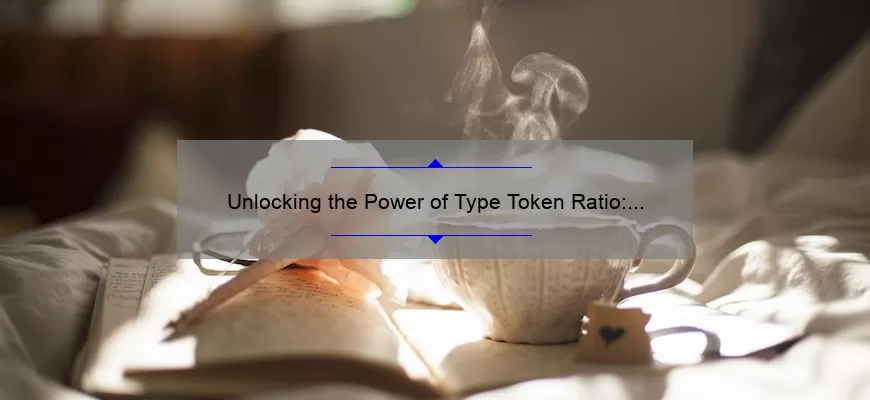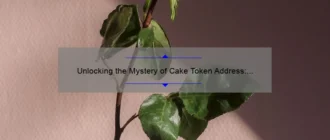How to Calculate the Type Token Ratio: A Step-by-Step Guide for Content Analysts
As a content analyst, one of the most important measures you need to calculate is the Type Token Ratio (TTR). TTR is a ratio that provides information on the diversity of vocabulary used in a particular piece of text. It determines the number of unique words used in relation to the total number of words found in your text.
A higher TTR score indicates greater lexical diversity, while a lower score means less variation in vocabulary choices. As such, TTR analysis can help identify potential issues with readability, stylistic consistency and even knowledge gaps amongst your target audience.
Here’s how to calculate TTR step-by-step:
1. Gather Your Text: To calculate TTR for any given document or website page, you’ll first need to gather all the text from that source.
2. Tokenize: Once you have your text gathered, you will then need to segment it into individual tokens (i.e., separate each word from its neighboring terms).
3. Count Your Tokens: Once you have tokenized your text, count up how many new types (unique words) there are compared with how many tokens (total words).
4. Calculate The Ratio: Finally use the formula below to find out what percentage of unique words are present in relation to total terms: Total Number of Unique Words / Total Number of Words * 100 = ________ %
For example:
If we had 500 tokens but only 200 unique ones…
Total Number of Unique Words / Total Number of Words * 100 = 200/500 * 100 =40%
Congratulations! You have now successfully calculated Type-Token-Ratio!
In conclusion, calculating Type-Token-Ratio is an effective way for content analysts to measure lexical variety within written language samples. With this easy step-by-step guide at your fingertips – remember these key points; tokenize your text into individual units using consistent criteria and then compare them according their uniqueness against all other terms used within the sample. Being able to calculate and interpret your TTR enables you to create content that is both engaging and effective! Happy analyzing!
FAQs on Type Token Ratio: Answers to Your Most Common Questions
Type Token Ratio (TTR) is a measure used in linguistics to determine the diversity of word usage in a given text or language. It is the ratio of the number of unique words to the total number of words in a sample. This measure has been popularly adopted by researchers and educators as a tool for assessing proficiency levels, identifying differences between languages and dialects, monitoring language development over time, and even predicting individual outcomes.
As TTR continues to play a crucial role in different fields, we thought it would be useful to provide some answers to common questions on this metric.
1. What does TTR tell us about language proficiency?
TTR can give us insights into someone’s linguistic complexity and fluency by measuring their vocabulary richness. A higher TTR indicates a more diverse use of words, suggesting that the writer/speaker has an advanced level of vocabulary acquisition and possibly higher linguistic competence.
2. Can TTR vary across different kinds of text?
Yes! The type of text analyzed can significantly affect its TTR score. For instance, academic writing generally has lower TTR scores since it employs technical jargon and frequent repetitions while literary writing – like fiction – tend to have higher TTR scores since they often use more varied language.
3. How reliable is TTR as a measurement tool?
While there are debates around its accuracy, TTR remains one among many standard measures employed by linguists. In order obtain accurate results with this metric it’s important that analysis considers factors such as wording variations over time or within specific contexts.
4. Does English language have higher or lower norms compared to other languages?
There is no universal norm when it comes to calculating typical values for Type Token Ratio—that said cultural factors and other external factors can influence what kind of norms are observed both within and between languages.
5. Is it possible for someone’s identifier trends drive their TYPE-Token Ratios?
It’s very likely that TTR can be influenced by language users’ semantic preferences and interests. A person who likes to write about dogs will probably have a higher frequency of dog-related terms in their vocabulary, which could skew the results of TTR analysis.
In conclusion, Type Token Ratio is a useful metric for quantifying and comparing the richness of expressive vocabulary – but its analysis should always be carefully evaluated either within relevant parameters or when evaluating variance factors. With continued exploration and careful application, we can leverage this measurement tool to learn more about language use across contexts and communities.
Top 5 Facts You Should Know about Type Token Ratio for Effective Content Analysis
Type Token Ratio (TTR) is a concept that has recently gained momentum in the field of content analysis. TTR calculates the ratio of unique words to total words in a given piece of text, including articles, essays, blogs, and other written compositions. This measurement method helps to determine the richness and complexity of vocabulary used in written content.
Here are the top 5 facts you should know about TTR for effective content analysis:
1. TTR is an indicator of content quality: A higher Type Token Ratio indicates that the text contains comparatively more unique words than repetitive ones. It means that the writer has put more effort into creating original and engaging content with contextualized vocabulary; hence it is considered an indicator of quality writing.
2. Depth vs breadth: One common debate within content writing revolves around depth vs breadth – whether to go wide or deep while exploring a topic. A higher TTR suggests depth over breadth as it emphasizes using complex words to convey explicit meaning relevant to a specific niche or context.
3. Variation across genres: The ideal Type Token Ratio varies according to different types of genres and target audience. For example, academic journals tend to have higher TTR as compared to popular magazines or blogs meant for general reading purposes.
4. Usefulness for SEO optimization: TTR plays a vital role when it comes to optimizing your articles for search algorithms’ readability features like Yoast SEO plugin or Google’s Word Density Checker tools based on keyword frequency distribution score; this feature checks plagiarism-free texts with ease by calculating distinctive words in comparison with overall writing volume.
5. Linguistic analysis tool: Lastly, Type Token Ratio can be utilized as an excellent linguistic tool in research methods concerning language development and assessment by comparing writers or speakers’ lexical diversity, sophistication levels – taken as their cognitive ability measure- against age groups or language proficiency levels.
To sum up, an adequate understanding of Type Token Ratio will help content writers enhance their writing skills, SEO optimization strategies, and provide linguistic insights for researchers’ language development assessment.
The Importance of Type Token Ratio in SEO and Content Creation
In the world of Search Engine Optimization (SEO), one important factor that many businesses tend to overlook is the Type Token Ratio (TTR) in their content creation. A high TTR value indicates a more diverse vocabulary, which can lead to better user engagement and ultimately higher search engine rankings.
At its core, TTR is a simple metric that measures the ratio between unique words used in a piece of text and the total number of words. For example, if an article contains 500 words and 250 unique words, then the TTR value would be 0.5 or 50%.
So why is this important for SEO? Well, search engines like Google prioritize websites with high-quality content that provides value to users. And one key aspect of quality content is diversity in language use.
By having a higher TTR score, you are not only proving to search engines that you have valuable content, but also demonstrating your expertise on a particular topic by using different word choices and phrases instead of repeating the same ones over again.
Additionally, having a higher TTR score can also help attract readers and increase overall engagement with your content. By using varied vocabulary and sentence structures, you are providing readers with fresh perspectives and ideas which can make your content more interesting and engaging.
However, it’s important to note that achieving a high TTR score shouldn’t come at the cost of readability or clarity. Using obscure or overly complicated language just for the sake of increasing your score could end up hurting rather than helping your website’s SEO efforts.
To sum it up, incorporating a wide range of vocabulary into your content will not only benefit SEO efforts but also enhance reader engagement through variety in language use. So next time you create content for your website or blog post – keep an eye on your type-token ratio!
In conclusion, by utilizing proper vocabulary techniques such as Type- Token Ratio within writing will undoubtedly give an edge over competitors who may neglect essential features like language diversity. As a result, this can help generate higher search rankings for your business, increasing engagement and lead conversion rates.
The Role of Type Token Ratio in Measuring Text Complexity and Readability
The world of written communication is filled with a wide variety of texts, from simple and straightforward news articles to complex and dense academic papers. As readers, we often intuitively recognize the differences in complexity and readability between these types of texts. However, measuring these factors precisely can be more difficult than it seems.
One tool researchers use to assess text complexity and readability is type token ratio (TTR). TTR calculates the ratio between the number of unique words used in a text (the “types”) and the total number of words in that text (the “tokens”). The higher the TTR, the greater the diversity of vocabulary used in a given piece of writing.
Why does TTR matter when considering text complexity? On one hand, a high TTR suggests that a writer has used a variety of words in their work, which can make for an engaging read – especially if those words are precise and accurately convey new ideas or perspectives. On the other hand, too many uncommon or technical terms may hinder understanding for less advanced readers or those outside a specific field. In other words, there’s a balance to strike between using unique vocabulary that adds depth vs. accessible language that doesn’t impede comprehension.
Additionally, examining changes over time in an author’s TTR can reveal insights into changes in style and overall growth as a writer. For example, dipping TTRs over time signaled Ernest Hemingway’s later reliance on simpler sentences and leaner prose despite his earlier more complex works involving higher levels of intertextuality.
As powerful as TTR is as an indicator for assessing text readability/complexity issues across different length scales- showing useful correlations at levels such as Sentences specifically described for young peoples eases understanding while longer wordier sentences appear more intelligent yet harder to comprehend easily.
However like most empirical methods there’s still its share challenges including poor descriptive accuracies inadequateness with homographic items ie words sharing identical spellings with alternative systemic Milt. hence situations such as matters within the science and medical research fields with recurrently used Latin or Greek words like acute, chronic that usually alter readability outcomes- leaving room for uncommon errors along the line when used solely.
In conclusion, while TTR alone cannot wholly capture other factors such as overall fluency and grammatical structure in a given text- for instance verbal metaphors and quality allusions which may add layers to understanding-, it can be an invaluable metric for providing insight into text complexity by gauging vocabulary diversity. Understanding how to balance a high TTR with clear language can offering benefits in engaging readers and connecting themes or ideas thereby proving why it’s so crucial to measure type-token ratio output for better writing communication both professionally and socially.
Leveraging the Power of Type Token Ratio for Enhanced Writing and Communication Skills
In today’s fast-paced and rapidly evolving world, effective communication skills have become the cornerstone of success. Whether you’re a blogger, marketer, entrepreneur, or simply someone looking to sharpen their writing skills, the ability to communicate your thoughts and ideas effectively has become an indispensable asset.
One approach that can help you enhance your writing and communication skills is leveraging the power of Type Token Ratio (TTR). TTR is a metric used to measure the richness and diversity of vocabulary in a given text. It measures the ratio of unique words (or word types) to total words (or word tokens) in a text.
A high TTR indicates that a writer employs varied and diverse vocabulary, which can make their writing more engaging, informative and interesting. On the other hand, a low TTR suggests that a writer might be using repetitive language or relying on cliches, making their writing less effective.
To put this in perspective, consider two versions of the same text – one with a high TTR and another with a low TTR:
Low TTR Version: “The dog was really happy when his owner came home.”
High TTR Version: “The canine was overjoyed upon his master’s arrival.”
While both versions convey the same message, the second version uses more precise language and paints a vivid picture for readers. This makes it far more engaging than the first sentence.
Beyond improving your ability to write punchier copy or convey complex ideas with clarity; harnessing TTR will invite innovation into your prose. For instance employing synonyms rather than repeating adjectives within narrative fiction will instantly bring color to your stories–allowing readers view familiar scenes afresh.
Incorporating high-TTT also enhances authorial authenticity by preventing plagiarism from far-off documents. By free-associating tangential information related to comparative phrasing-in effect-pulling together facets from different texts associatively without fixed directions — authors reduces are less likely to copy-paste than when writing with a limited lexicon.
Enhancing your TTR isn’t just about impressing readers, though– it’s also about building a more nuanced understanding of language. The process of seeking out new and striking vocabulary unearths all sort of interesting trivia from word-roots to homographs that unveil the origins and oddities of languages. For instance, composing works around certain subjects will expand one’s depth for synonyms and expose subtly different definitions in relation to the context – as such mastery over language is no longer only functional but fun too!
Overall, leveraging the power of Type Token Ratio can help you enhance your writing by adding depth, nuance and precision to your prose while opening up new ways of exploring language. Whether you’re seeking to improve your professional communication skills or simply looking for ways to enjoy acquiring knowledge, taking time refine vocabulary is enriching way develop language proficiency: allowing prose color variation as well as comfortable clarity especially when task match brainwaves.






